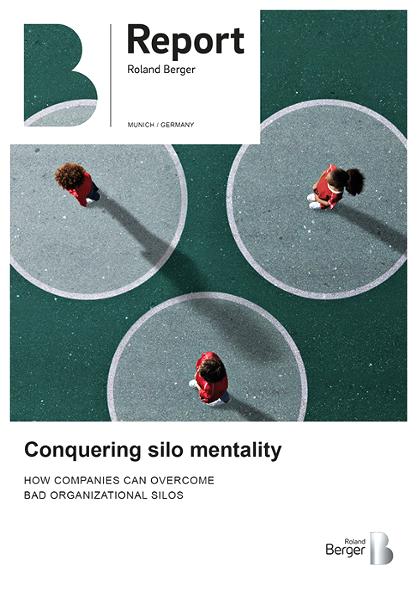Roland Berger is the partner of choice for strategic realignment, financial consolidation and operational excellence. Contact us now.


Breaking “bad” silos starts with executive and employee buy-in
How breaking "bad" silos can benefit your companies operations and overall business performance
New year-long study by Roland Berger finds nearly 80% of companies contain siloed teams but only 20% know how to fix them. Here’s what to look for.

Organizational silos are a big problem, according to a year-long study of more than 100 global businesses conducted by Roland Berger. In fact, nearly 80% of surveyed respondents report “strongly pronounced” silos that negatively impact their company’s costs, innovation potential, culture, and profitability.
Despite this, only 54% have made breaking bad silos a top company priority, the study found. Regardless if respondents had more than 5,000 employees or under 500, the results were largely the same — most respondents didn’t have the confidence or know-how when combating the problem. Just 20% report having the right measures in place.
The good news is there are several proven strategies for conquering silo mentality. Sadly, more than half are failing to implement these strategies, the study found. This is largely due to a lack of executive commitment and employee motivation. Here’s why.
"According to our study, we believe decision-makers are well aware that their companies are negatively organized as silo-like structures, and that this structure has a negative impact on business performance."
Old Dog, New Tricks
Rigid departmental structures can be traced back to the “Taylorism” movement of the early 1900s, which successfully helped improve the productivity of manufacturing companies. Today’s companies, however, are largely service oriented ones competing in a much more technologically complex environment. That’s a challenge for the majority of companies, our survey found.
In fact, only 54% of survey business have made breaking “bad” silos a top priority. Just 35% are confident they know how to do so. And only 20% believe they have the right measures in place to overcome unwanted silos that cripple collaboration and hinder profits.
According to our study, we believe decision-makers are well aware that their companies are negatively organized as silo-like structures, and that this structure has a negative impact on business performance. We also believe executives and employees are discouraged by the decades-old practice of separating teams, processes, and technology.
Moving The Needle
To achieve company-wide collaboration, faster time-to-market, and higher profitability, today’s companies must work as cross-functional teams and break down the decades-old existence of silo departments. As our full study demonstrates, we believe employee motivation, management commitment, and current awareness are the three biggest keys to evolve from a silo-based business. The end goal is better (if not more unified) vision, more collaborative processes and technology, and improved workplace socialization and trust between departments.
In addition to understanding how silos negatively impact today’s companies, our study identified which initiatives have the greatest impact on containing bad silos, and how extensively they are used. What we found is that almost half of the most effective initiatives that can break bad silos and unify companies are often neglected. For example, most companies provide cross-functional networking tools but don’t incentivize teams or individuals to actually use them in the way they were intended, so they often go unused.
Our research shows, however, that all of these initiatives can have a huge impact in breaking bad silos. Cross-functional committees, team building events with upper management, cross-sectional mandates and events, and end-to-end process definitions are a great start and something most companies are already doing. But to truly position their companies for the 21st century, the majority of companies still have a long way to go.
Getting Help
Of all the available strategies to breaking down bad silos, there are five in particular that, in our view, are the most crucial to finding success. As we detail in our fully study, these measures aren’t exactly rocket science, but they do require significant amounts of change management as old habits are hard to break.
Like so many transformation programs, breaking bad silos usually fails from a human change perspective, not an IT infrastructure one. Yes, there are technological challenges to securing a cross-functional company. But the biggest challenge is changing how your executives and employees think about the collaboration process. The best way to do this is changing the incentives and clearly articulating the vision.
Having helped thousands of clients over the years, Roland Berger knows first-hand how bad silos negatively affect productivity, collaboration, and profitability. Given our extensive experience as change agents for overcoming silo mentality, we look forward to engaging with you in exciting discussions.
To learn more, please see our full publication on Conquering Silo Mentality or contact us.
Register now to download the full study to learn more about breaking “bad” silos and conquer silo mentality to improve company-wide collaboration, time-to-market and enhance overall business performance.




